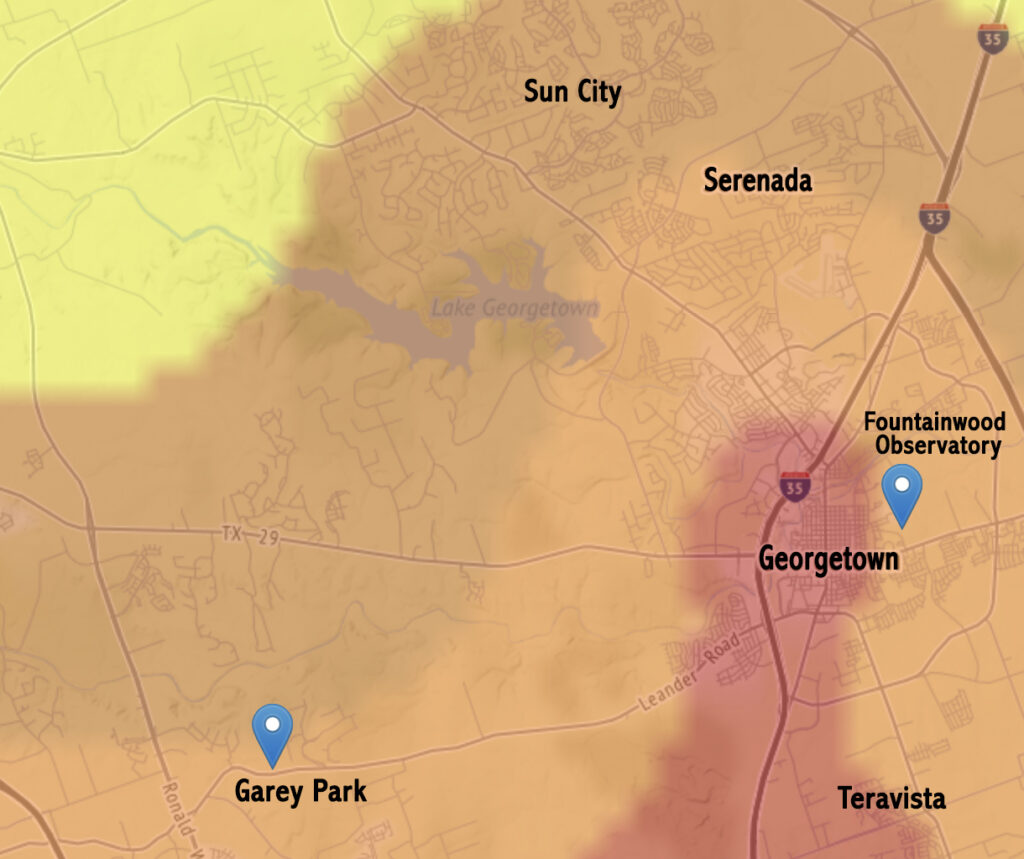The stars at night are big and bright in the heart of Texas…and there are several ways to enjoy them in Georgetown. We are also fortunate to have expert resources nearby to help guide us to and understand what we’re seeing in the night sky.
Thanks to our Parks and Recreation Department we have several opportunities each year to spread a blanket on the grounds in Garey Park and take advantage of professional equipment. We are also fortunate that these public stargazing nights, thanks to a partnership with Southwestern University, include the expertise of Dr. Mark Bottorff, the University’s Associate Professor of Physics.
Dr. Bottorff is well-known for his ability to translate complex astronomy data into manageable bits to help non-science majors understand things like gravity, lunar phases and more. He does most of his work at the Fountainwood Observatory on the campus, but his students are doing some stargazing at Garey Park due to renovations. Students frequently make observations from the park due to its proximity and relatively dark skies.
Star Parties
Georgetown Parks & Recreation Special Services Superintendent Traci Stengle explains public stargazing nights offer opportunities for residents to look through “big” telescopes and talk to experts about celestial sights visible from right here at home.
At the Garey Park events, Dr. Bottorff and seasoned observers from the Williamson County Astronomy Club (WCAC) help demonstrate what astronomy has to offer. Club members are encouraged to bring their own telescopes so there are a variety of instruments for participants to use to scan the skies. Traci also recommends dressing appropriately and guests may bring refreshments (no glass).
Pre-registration for the Garey Park events is required; event attendance is capped to make sure everyone gets adequate time with the professional equipment. Families are welcome, and there is a fee you can pay online.
Parks.georgetown.org/public-stargazing-nights/
Upcoming
November 21st 7:00 pm – 9:00 pm
Gates open at 6:30pm, last entry into the park at 7:30pm
December 19th 7:00 pm – 9:00 pm
Gates open at 6:30pm, last entry into the park at 7:30pm
For weather updates, contact Garey Park 512–930-6800 or check their Facebook page for any up-to-the-minute changes.
When the Fountainwood Observatory renovation is complete, expected in 2020, SU will resume monthly open house events, usually scheduled on the Friday nearest the quarter moon. The Williamson County Astronomy Club is also available to present a limited number of star parties for area schools and community groups. These outdoor observing events are held Friday evenings, on school grounds, when club members and school students are available to stay out later. The outings are a great opportunity to educate children and their parents in the visual aspects of astronomy and supplement what they have learned in class. Visit them at Williamson-Astro.org

The Bortle Scale rates how well you can see celestial objects in a certain place, taking light pollution and sky glow into account. Lower numbers indicate darker skies. For example, Big Bend Ranch State Park, pictured here, has a Bortle Scale rating of 1… it is the darkest place in Texas.
DarkSite maps do not take weather into account; particularly humidity. Moisture in the air tends to scatter skyglow over greater distances. Air with low moisture content can yield darker skies even close to a town. All things being equal, the same color zone will be darker in a dry climate compared to a humid one.
Consider what it is you want to observe and find a site that’s darkest in that direction. Most of the time, having a dark sky to the south is most important for seeing the milky way. But for seeing the aurora borealis, you want a dark sky to the north.
For viewing planets, or the Earth’s moon, light pollution is not a concern, as long as you can move away from the glare of nearby lights.
